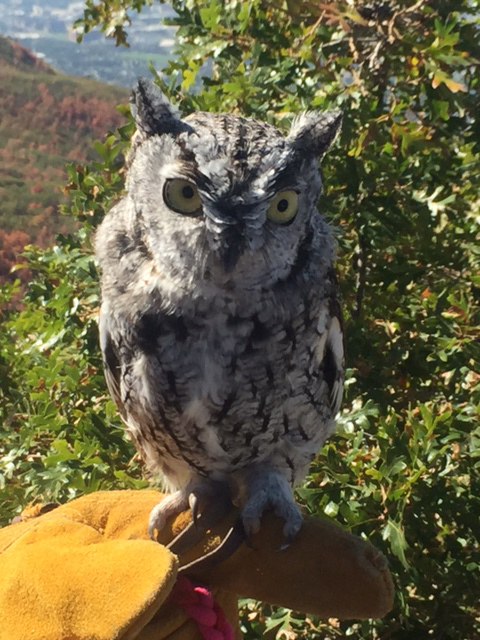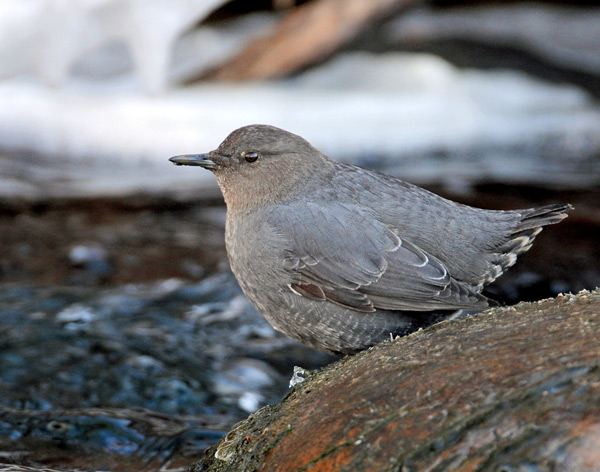Utah County Birders Newsletter
|
 |
Contents
October Meeting
Upcoming Field Trips
Captain's Log
Bird of the Month
Backyard Bird of the Month
September Hotline Highlights
OCTOBER MEETING:
Thursday, October 13th, 2016
Our
meeting this month will be a documentary night!
We're going to start a new tradition where once or twice a year we'll watch a
bird documentary. We'll be starting right at 7 so we have enough time to finish
the film.
Meet at 7:00 pm at the Monte L. Bean Museum. 645 East 1430 North, Provo, UT
http://mlbean.byu.edu/
Saturday, October 8th, 2016: All day. The Big
Sit - Continuing our long-standing tradition, we will be holding a
Big Sit where we count birds seen from a 17' circle on the Provo Airport Dike.
This year we will be counting at the same location as the last couple of years
on the southwestern corner. Please come and join us for as little or as long as
you would like. Various people will be helping out this year, but if you show up
and no one is there, we will hopefully have the circle scratched out in the
dirt, and you can keep a tally of all the species you see from inside the circle
and the time you are there and report it to keeli.marvel@gmail.com.
Saturday October 15th, 2016: 7am-noon. We are going to bird the
International Center and Lee Kay in SLC.
Meet at 7am at the AF park and ride to carpool. We'll look for rare gulls and
late season migrants.
We are actively recruiting people to lead local half-day field
trips, any time, any place. If you would like to lead a field trip or if you
have any ideas for this year’s field trips, please contact Keeli at -
keeli.marvel@gmail.com
Utah County Birders
Captain’s Log: October 2016
by Keeli Marvel
 |
  |
|
Hawkwatch day at Squaw Peak |
Hello fellow birders. How’s migration birding going? A couple weekends ago we
had a successful hawk watch up at Squaw Peak. Thanks to everyone who came out,
and especially to Hawk Watch for hosting the count and bringing the cutest
education birds – a Western Screech Owl and a beautiful Swainson’s Hawk – to
share with us. Over 200 raptors were counted, with Cooper’s Hawks and Turkey
Vultures making up the majority of birds sighted.
I don’t have any epic trips to report on, but I’ve tried to make an extra effort
get out here and there, especially after each wave of wet/cold weather. I
haven’t been able to catch anything too vagrant yet, but I’ve seen some
interesting patterns in the birds migrating. A couple of weeks ago I went for a
morning walk along the lake by my house and there were Lincoln Sparrows
everywhere. After seeing them at home, I saw them at work as well. It also
seemed like Wilson’s Warblers went through in a mad flush and I felt like every
time I went out I saw Wilson’s Warblers. Last week at work I walked around
housing and saw a couple of Gray Flycatchers, a Wilson’s Warbler, a Red-naped
Sapsucker, and Townsend’s Solitaires. A couple nights ago I was hanging out at
an outdoor festival in north Salt Lake around dusk and saw two Common
Nighthawks, which was interesting because I haven’t seen any for a few weeks.
And this past week, I’ve had two different non-birders ask me if the Turkey
Vultures were migrating because they’d each seen huge kettles of them in places
where they aren’t usually seen hanging out. Just some interested things to note.
Still hoping for something rare, but I appreciate every opportunity to get out
and see the birds.
Something interesting I was reading about this week – did you know that birds do
not have vocal cords like mammals (including humans) do? Bird vocalizations are
produced not through the larynx, like mammals, but by a structure further down
in the trachea called the syrinx. It is located at the base of the trachea where
it branches into the lungs. Both branches can be independently controlled, which
means that many bird species can produce two separate noises at the same time –
basically they could sing duets with themselves if they wanted to. How birds
create so many different vocalizations is not very well understood, but it’s
thought that for the most part it is learned behavior that accounts for the wide
variety of bird calls and songs rather than differences in physiological
structure. There’s been some research done on identifying the region of birds’
brains that controls song and it appears that the bigger the region, the better
the singing ability. In fact, in some bird species where the females don’t sing
at all, there’s a direct correlation to reduced size of that brain region. Birds
who are exceptional mimics must have well-developed singing brains. Super
interesting!
Well, that’s all I’ve got for now.
Keep on keepin’ on, and happy birding!
Keeli Marvel
 |
|
photo by Paul Higgins |
American Dipper
Cinclus mexicanus
by Landon Jones
[Rerun article from October 2008]
Last week I went to a lovely picnic at
South Fork Canyon Park with my good friend and his family. He just finished law
school and got a good job with a law firm, and I hadn’t seen him for a year of
so. After discussing his work a little he asked me if there were any strange or
interesting birds in Utah. Pointing to the stream running through the park, I
told him about one of the most amazing and specialized birds in the U.S., the
American Dipper.
The American Dipper, Cinclus
mexicanus, frequents fast-flowing mountain steams and rivers year-round. It
obtains food by diving under water, walking upstream against the current, and
turning over rocks and searching along the bottom for tasty invertebrates.
“What???!!!” I said in my mind, the first time I heard this. “Surely I must have
heard incorrectly.” No, you heard it right. “It walks underwater, not swims, in
mountain streams created from snowmelt, even in the winter, and eats bugs off
the bottom?” Yes. “That’s crazy! How can it do that??!!” Dippers sport some
fascinating adaptations for their frigid aquatic lifestyle.
Most aquatic birds are fairly large, so as to conserve as much body heat as
possible, but dippers are rather small at about seven and a half inches in
length. Larger animals retain more heat as they increase in size because their
volume increases little as mass increases, leaving less surface area for heat to
dissipate away from them, keeping them warmer. Dippers also have little in the
way of fat reserves compared to other aquatic birds. They do, however, have lots
of down feathers, to keep them warm while diving, which is quite a divergence
from the typical passerine body plan. Dippers also have an enormously enlarged
preen gland (ten times the size of other passerines), which allows them to
waterproof their numerous feathers. Water just rolls off them as they come up
for air after a dive. Also related to thermoregulation, dippers have very short
tails and wings compared to other passerines. Long tails and wings would quickly
dissipate much of the heat necessary to keep them warm. Their body plan is as
close to a sphere as possible, the most efficient shape for heat conservation,
without compromising other morphological traits necessary for life in their
habitat. Dippers can survive winter temperatures as low as -49° F.
Dippers are also well-adapted to their unique environment. The first time I saw
an American Dipper, I thought it was a rock on a sandbar in the middle of the
river until it moved and sang its clear notes. Their plumage blends well with
their surrounding habitat. Logically, dippers would do well in the water with
webbed feet, but as passerines, their feet are fixed in the typical passerine
toe configuration, which constrains the development of this trait. However,
dippers have strong legs and well-developed claws, allowing them to forage on
the stream bottom under continuous pressure against the fast-moving current.
Their chest muscles are also very strong compared to other passerines so they
can flap their wings underwater, their primary means of locomotion in their
habitat. They also have a third eyelid, which is clear and protects their vision
underwater (built in goggles, wouldn’t that be handy!). They also have movable
flaps to cover their nostrils when diving (and noseplugs too!).
American Dippers defend linear stretches of streams as their individual
territory, year-round. One of their most interesting attributes that they share
with no other bird outside their family is a feathered eyelid. The eyelid is
white and conspicuous against their drab gray plumage, warning other dippers to
stay out of their territory. This adaptation allows them to stay relatively
incognito from predators most of the time, but the flash of white is
unmistakable when they want to be noticed.
Dippers are in the family Cinclidae, and all are in the genus Cinclus. There are
only five species in the world, almost one for every major continent. The
American Dipper (Cinclus mexicanus) resides in western North America,
from Alaska to Panama. The Rufous-throated Dipper (Cinclus shulzii)
occurs in South America along with the White-capped Dipper (Cinclus
leucocephalus) which is confined mostly to the Andes mountain range. The
White-breasted Dipper (Cinclus cinclus) is distributed throughout Europe
and into a little bit of North Africa. The Brown Dipper (Cinclus pallasii)
is found throughout Asia. Dippers are currently placed as most closely related
to thrushes. However, their unique adaptations to take advantage of a very harsh
and specialized feeding niche make them, in my eyes, birds nothing short of
miraculous. When I ask birders from the east coast what species they would like
to see in Utah, they often say “show me one of those dippers.” The concept of an
American Dipper is simply unreal until you have seen one; they are truly one of
the marvels of the west.
If you would like to
write an article for the Bird of the Month, please contact
Machelle -
machelle13johnson@yahoo.com
Click here for past 'Birds of the Month'.
September 2016
Jack Binch - Sandy
I had a Black-chinned Hummingbird at 6:00 this evening. (30 Sept 2016). Hate to see them leave.
Suzi Holt -
Payson
I love when the Common Nighthawks do a flyover over my house in Payson.
Such a great sight to see!
Eric Huish - Pleasant Grove
Black-capped Chickadees - Regular visitors all month's. But I enjoyed them more this month.
Keeli Marvel - Saratoga Springs
A MacGillivray's Warbler in my backyard after one of the storms came
through. I heard a super strong chip so I followed the noise and found a
MacGillivray's in my tree. I also saw a pair of Great Horned Owls around
dusk in my neighborhood a few weeks ago. I heard them hooting and then saw them
both flying.
Milt Moody - Provo
A pair of Downy Woodpeckers came to check out my trees.
Alton Thygerson - Provo
Cooper’s Hawk - Over the past couple of years we’ve had a Cooper’s Hawk
family nesting in the neighborhood. The larger trees in my yard have providing
infrequent daytime perching places.
Report your favorite backyard bird
each month to Eric Huish at 801-360-8777 or
erichuish@gmail.com
Printable Version of this UCB Newsletter